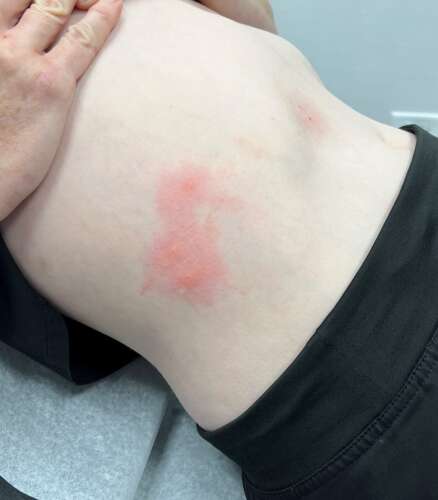An increase in biting mites that feed on periodical cicada eggs has led to itchy rashes for some people
Courtesy of Derick Dermatology
The distinct song is fading and millions of periodical cicadas, as if by magic, are disappearing.
But like the last emergence 17 years ago, a corollary effect has left some people scratching unexplained red welts appearing seemingly out of nowhere.
The culprit is a microscopic mite.
“You can’t see them, you can’t feel them, they’re always here,” explained Jennifer Rydzewski, an ecologist for the Forest Preserve District of DuPage County. “But because of the cicadas, they have a food source (and) their population has exploded.”
Pyemotes itch mites are parasites that prey on insects in sheltered locations, including the eggs of cicadas deposited weeks ago beneath tree bark.
Rydzewski recalled an uptick in people reporting mysterious itchy rashes after the last periodical cicada emergence. Knowing colleagues may experience it firsthand or get questions, she alerted staff as a preemptive strike.
“I said, ‘You know what? It’s going to happen again,’” she said. “You could see cicada eggs everywhere.”
The eggs laid by female periodical cicadas in June hatch from mid-August to September. Egg nests provide protection and a food source for mites, which typically feed on insect larvae found in hardened bumps called galls on tree leaves, especially pin oaks.
According to the Illinois Department of Public Health, itch mite bites can develop into small, blisterlike bumps with large red circles around them that can resemble a skin rash.
Doctors at Derick Dermatology, which has 19 suburban locations, noticed an influx of patients with symptoms of mite bites the past two or three weeks, said Dr. Amy J. Derick, company CEO and president of the Illinois Dermatological Society.
An office in Park Ridge, where there was a sizable cicada presence, reported treating five cases a day, Derick said. Another provider saw a higher occurrence in Oakbrook compared to Barrington, for example, and it appears the incidence of mite bites correlates to local cicada populations, she added.
“Fortunately, these mites cannot live on humans, do not survive indoors and are not known to transmit disease,” Derick said.
Bites typically occur around the neck, shoulders and chest where the mites land after dropping out of infested oak trees. Symptoms of an itchy rash typically begin in 10 to 16 hours and can last a week or two.
Typical insect repellents are not effective against the oak leaf itch mite, but if you shower and wash clothing after being outside the risk of infection can be lowered, according to Derick.
IDPH says to wash the bite with soap and water; promptly apply an ice pack to the bite area to reduce swelling, itching and pain. Calamine, oral antihistamines and over-the-counter topical hydrocortisone products may be beneficial, according to the agency.
Topical steroids being prescribed help decrease the itch, Derick added.
Itch mites feed on cicada eggs.
Courtesy of Ed Zaborski, 2021
